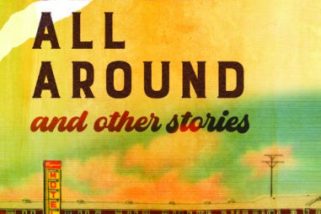“No Faith Without Body” excerpt by Cassie Premo Steele
The Catholic Church taught me about pain.
My first sexual assault happened while I attended a Catholic elementary school, I had been assaulted by a Catholic boy in high school, and the Bishop decided to close my high school that was an intellectual and spiritual haven for women.
Immaculata, named after Mary and honoring her immaculate conception, put this narrative about pain in the context of women’s bodies, women’s lives, women’s minds.
The nuns and teachers there provided a role model for what being faithful might look like, and it wasn’t about submission. It wasn’t about resistance, either. The all-female campus where men and boys were not allowed gave us a space to envision ourselves becoming a self apart from patriarchy.
Of course, this also happened with the larger reality of Washington, D.C., the Capitol and White House, and the Catholic Church right outside our window.
The order of nuns who ran Immaculata were the Sisters of Providence.
What they instilled in me was a deep understanding of providence working in concrete, detailed and invisible, grand ways in my life.
–
Before the church was the dominant paradigm in Ireland, people lived close to the land. The fairies and goddesses, warriors and queens of the ancient Celts provided ways for the people to make sense of seasons and weather, life and death, pain and healing.
Brigid was the Celtic goddess of poetry. She also ruled over fire and healing and metalwork.
The first three made sense to me, but I did not come to understand metalwork until one day, typing away at my computer, I suddenly saw the metal of it.
The metal of the box that held it. The metal wires and components inside. The metal conduits to the electrical grid that brought power into it. The metal towers that provided signals and service for this communication.
And I realized that the ancient ways, once again, held wisdom for the future in them that we cannot even comprehend until later.
Providence.
–
The thing about Brigid is that the Celts loved her so much that they refused to let her go when the Catholic Church came.
So her story was rewritten to fit the narrative.
Suddenly, she was able to move back in time and space to become the midwife to Mary at the birth of Jesus. This made sense thematically, as she was the goddess of healing, but it made no sense geographically.
The people accepted the story, though, as they learned to hear the word “mystery” and nod even if they couldn’t understand.
The important thing is that they were able to keep their Brigid.
When I learned this history, I thought again of the closing of Immaculata, and it occurred to me how hard women have had to fight to find spaces that were safe for them to grow outside of a patriarchal power structure. And how often this attempt has failed.
–
There are springs all over Ireland, tiny little things sometimes, coming out of the ground or bubbling through the walls of small caves, that are dedicated to Brigid.
There is one in Liscannor, where my great grandfather lived before leaving forever to emigrate to America.
I did not find it by researching it. I followed my instinct and felt it.
I had written a novel that took place in Ireland before I ever even went there, and when I did go, I wanted to visit the places where my maternal great grandmother and great grandfather had been born.
She was from Miltown Malbay in County Clare, and he was from Liscannor, also in County Clare and right across the bay.
I did not know these things before I went there.
I stood on the tiny blacktop behind her elementary school, a small brick square next to the water, and I looked out across the bay.
She would have done this, too, as a child.
The next day, my husband and I (we had left our toddler daughter at home with a dear friend) drove around the edge of the water from Miltown Malbay to Liscannor.
I got out of the car and looked back across when I got there.
On the other side, barely visible, was my great grandmother’s elementary school.
They never met until they came to America, each separately carrying the pain of famine and the hope of Catholicism and the strength of Brigid.
When they talked about where they were from, I imagine, they realized they could, quite literally, picture it.
Providence.
–
I also saw from walking the land in both places that Miltown Malbay was a town with a large brick church, with streets and shops, and soft rolling landscapes surrounding it with rich, dark soil.
One of the people in town, when I told him I was walking the steps of my great grandmother, told me that it was possible in Ireland to know exactly where someone is from. Not from books or written records, but because the land boundaries were always drawn according to bodies of water.
A creek here. A bay there. And a stream.
The water would never migrate, as long as it was allowed to flow, and so one could know exactly what patch of land a person had come from.
When I walked the land in Liscannor, it was dry and rocky. The slopes were steeper. Instead of a church and shops, there were stone ruins of old houses, the outlines of who had lived there and left, leaving only the rocks behind.
What a tough man, Denis Clair, my great grandfather, must have been to survive here and leave here, I thought to myself. How soft he must have found Mary Agnes O’Connell, I imagined, when she told him of her little elementary school and the green, round land she grew up upon and left behind so she could look for work.
We got back in the car and I told my husband, “Go that way.”
I was following an inner knowing. A homing instinct.
We drove up a hill and took a road that went left and wound higher on the landscape.
And there it was.
The graveyard.
We got out of the car and started to walk.
The church, I realized, had not been in the village closer to the shore but had been located up here where there was more air and a better view.
The gravestones were old and gray, but the names were still legible.
There they were. The Clairs. The ancestors. John and Denis and Mary and Anna and the names that would be carried across the ocean and handed down.
It took my breath away.
How easy it had been to find.
My instincts were so strong.
Providence.
–
We left the graveyard and walked toward the church. And there, nestled into a hillside, was a small cave.
Inside was a sacred well of Brigid.
I walked through the cave opening where there were candles, lit and lighting the way, and wax from those that had burned away.
Along the walls were tucked hundreds of photos and notes for Brigid. Prayers of petition and gratitude. Asking for healing. Expressing thanksgiving.
I took the photo of my daughter that I carried with me on the trip and I held it to my heart.
I loved her so much.
I missed her.
I wished she had been with me.
I so wanted to be a good mother.
I still carried so much pain.
I did not want to pass it on to her.
I had such great faith.
I also had immense sorrow.
I loved her so much, I said to Brigid again.
Here, I said, placing the photo gently on the damp rock, have her.
Take her into your healing spring and protect her.
Do for her what I cannot.
We need more than one mother.
We need midwives, too, that’s for sure.
Be my midwife, okay, Brigid?
Because I knew, deep in my heart, that I was nowhere near done giving birth to my daughter or myself.
Providence.
–
When people talk about faith in America, they usually mean Protestantism. A politically conservative, proudly homogenous, clean and upright kind of people.
What I mean by faith was in that cave that day: something wet and mucky and crammed with a variety of needs and sorrows. The cave itself, the way it holds bodies, as an earthly manifestation of how we can be carried by faith.
There I was, in the land of my ancestors, in my body. It was their bodies that made possible my body. It was my body that gave birth to my daughter’s body.
A faith without the body makes no sense to me.
Especially because it is also the body that carries our trauma and pain.
____________________
Cassie Premo Steele is a lesbian, ecofeminist, mother, poet, novelist, and essayist whose writing focuses on the themes of trauma, healing, creativity, mindfulness, and the environment. She holds a Ph.D. in Comparative Literature and Women’s, Gender and Sexuality Studies from Emory University in Atlanta, Georgia, and she has published 16 books, including 6 books of poetry, and her poetry has been nominated 6 times for the Pushcart Prize. She is a recipient of The Archibald Rutledge Prize and The John Edward Johnson Prize, as well as the Carrie McCray Literary Award for Poetry, and she was a Finalist for the Rita Dove Poetry Award judged by the current US Poet Laureate Joy Harjo. She lives in South Carolina with her wife, dog and 3 chickens.







